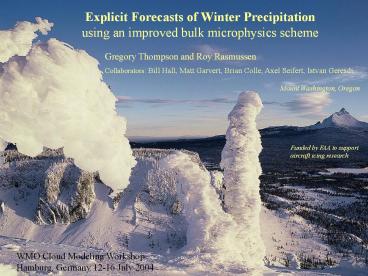Explicit Forecasts of Winter Precipitation using an improved bulk microphysics scheme - PowerPoint PPT Presentation
1 / 21
Title:
Explicit Forecasts of Winter Precipitation using an improved bulk microphysics scheme
Description:
Explicit Forecasts of Winter Precipitation ... (SLDRP) deep and dynamic snowstorm w/classic FZRA. 2001 Feb 01-02 ... Description and sensitivity analysis. Mon. – PowerPoint PPT presentation
Number of Views:120
Avg rating:3.0/5.0
Title: Explicit Forecasts of Winter Precipitation using an improved bulk microphysics scheme
1
Explicit Forecasts of Winter Precipitationusing
an improved bulk microphysics scheme
Gregory Thompson and Roy Rasmussen
Collaborators Bill Hall, Matt Garvert, Brian
Colle, Axel Seifert, Istvan Geresdi,
Mount Washington, Oregon
Funded by FAA to support aircraft icing research
WMO Cloud Modeling Workshop Hamburg, Germany
12-16 July 2004
2
Outline
- 2D simulations
- idealized flow simulations using 2-d version of
MM5 (PSU/NCAR) - 18 sensitivity experiments plus 4 different
cloud depths - bulk scheme tuned to Geresdis bin/explicit
model - key results from sensitivity experiments
- 3D case studies
- one of numerous cases from variety of field
projects - different precip formation mechanisms
- different geographic regions (continental/maritim
e) - Future work
- verification data
- other bulk species (aggregates) or 2-moments?
- WRF model simulations
3
Idealized 2-D simulations
original R-G sounding
increase moisture to create deeper and colder
clouds
modified sounding
4
MM5 microphysics testing in 2-d
5
2-D sensitivity experiments
- primary ice initiation
- autoconversion (cloud to rain)
- CCN spectra (maritime v. continental)
- graupel
- gamma vs. exp size distribution
- rimed snow to graupel conversion
- snow size distribution
- y-intercept constant
- y-intercept depends on mass
- y-intercept depends on temp
- rain size distribution
- cloud depth increased to lower temps
6
Bin versus Control and Final bulk schemes
7
Key results of 2D bulk micro experiments
1. The choice of ice initiation schemes is
relatively unimportant for deep, precipitating
snow clouds but more important for shallow, warm
clouds having cloud-top temperatures greater than
13C.
8
Key results of 2D bulk micro experiments
2. The assumed snow size distribution and
associated snow diffusional growth have major
impacts on the mass of supercooled cloud water
and formation of freezing drizzle.
snow depositional growth
M-P y-intercept
9
Key results of 2D bulk micro experiments
Snow depositional growth
3. The assumed graupel size distribution and
method of transforming rimed snow into graupel
have major impacts on the mass of supercooled
cloud water and formation of freezing drizzle.
Snow riming growth
relative ratio
13
11
10
Key results of 2D bulk micro experiments
4. A proper simulation of drizzle using a
single-moment scheme and exponential size
distribution requires an increase in the rain
intercept parameter, thereby reducing rain
terminal velocities to values more characteristic
of drizzle.
orig. rain
graupel
snow
new rain
11
2-D Workshop case3
12
Case Studies
- 1990 Feb 13-14 (WISP)
- shallow, post-frontal, upslope cloud w/widespread
FZDZ. - 1998 Jan 30 (NASA-SLDRP)
- shallow stratoCu, primarily CLW w/slight FZDZ.
- 1998 Feb 04-05 (SLDRP)
- deep and dynamic snowstorm w/classic FZRA.
- 2001 Feb 01-02 (IMPROVE-1)
- deep PacNW frontal system, abundant precip.
- 2001 Nov 28 (IMPROVE-2)
- deep PacNW frontal system plus orographics.
- 2001 Dec 13-14 (IMPROVE-2)
- deep PacNW frontal system plus orographics.
13
30 Jan 1998 NASA Twin Otter flight
Canada
Lake Erie
Pennsylvania
Ohio
14
30 Jan 1998 Cleveland, OH sounding
15
30 Jan 1998 cloud-top temperature
16
30 Jan 1998 liquid water content
gt95 of water mass in drops less than 30 microns
17
Future
- Expand analysis/verification
- how to verify snow/graupel mixing ratios
- surface precipitation
- composite pattern, lots of cases
- include AIRS2 and other cases?
18
Future
- Expand analysis/verification
- how to verify snow/graupel mixing ratios
- surface precipitation
- composite pattern, lots of cases
- include AIRS2 and other cases?
- Comparisons to other models
- bin/explicit model of Geresdi
- THIS WORKSHOP
19
Future
- Expand analysis/verification
- how to verify snow/graupel mixing ratios
- surface precipitation
- composite pattern, lots of cases
- include AIRS2 and other cases?
- Comparisons to other models
- bin/explicit model of Geresdi
- THIS WORKSHOP
- Put into WRF model
- std-version 2-moment
- Hall/Seifert modifications
20
Future
- Expand analysis/verification
- how to verify snow/graupel mixing ratios
- surface precipitation
- composite pattern, lots of cases
- include AIRS2 and other cases?
- Comparisons to other models
- bin/explicit model of Geresdi
- THIS WORKSHOP
- Put into WRF model
- std-version 2-moment
- Hall/Seifert modifications
- Other micro species
- aggregate category?
- drizzle category?
- hail category?
21
Microphysics more detailed reports
- Thompson, Rasmussen, Manning, 2004 Explicit
forecasts of winter precipitation using an
improved bulk microphysics scheme. Part I
Description and sensitivity analysis. Mon. Wea.
Rev., 132, 519-542. - Thompson, Bernstein, Rasmussen, 2004 Explicit
forecasts of winter precipitation using an
improved bulk microphysics scheme. Part II Case
studies. Mon. Wea. Rev., in preparation. - JAS - IMPROVE special issue (late 2004).































